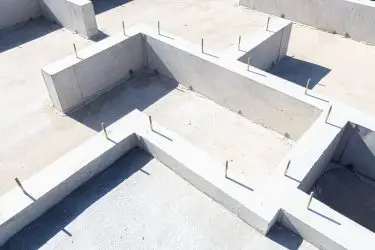Concrete is one of the toughest materials for building sidewalks, driveways, and more. It’s affordable and easy to make, which is why you’ll find concrete almost everywhere in cities of all sizes, but concrete isn’t as durable as you might think. Without proper reinforcement, it faces several challenges.
Concrete needs reinforcement because it’s weak against tension pressure. It can withstand compression, but stretch motions and side-to-side movements crack unsupported concrete quickly. Rebar and other types of steel are used to provide optimal reinforcement for concrete, limiting stress fractures.
Throughout this article, you’ll also learn the following information about why concrete needs reinforcement:
- Several reasons concrete requires additional support
- Various materials used to reinforce concrete and reduce cracks
- Multiple examples of what happens if the concrete isn’t supported correctly
- Stress test examples of rebar’s influence on concrete pads

Table of Contents
What To Know About Concrete Reinforcement
Concrete reinforcement is designed to prevent various structural issues. Contrary to what you might believe, not all concrete needs rebar to support itself.
Numerous factors influence concrete’s durability, longevity, and resistance to all three types of pressure. Let’s dive into a list of five things you should know about concrete reinforcement below.
- Concrete isn’t durable against tensile pressure. There are three types of pressure applied to concrete: tensile, compression, and shear. Tensile pressure is the stretching or pushing force that shoves concrete in different directions. Since concrete isn’t made for this pressure, it needs a rebar for support.
- It’s strong when compressed under inward force. Concrete is designed to deal with thousands of pounds of compression, which is why you can park a car on it without facing any challenges. Compressed concrete isn’t a problem, but when tensile pressure is applied, you risk breaking the surface.
- Shear pressure can move and crack concrete. This type of pressure moves side to side, cracking the concrete like an earthquake. Fortunately, some rebar structures can prevent damage caused by shear pressure. It’s worth asking the building company if you’re hiring professionals.
- Not all concrete requires additional reinforcement. Some concrete applications can withstand enough pressure without cracking or pulling apart. However, you need to know the concrete’s depth before you decide to forgo reinforcement. For more information, read our article ‘What Concrete Requires No Reinforcement?‘.
- Reinforcement is suggested for concrete at or below five inches (12.7 cm). Anything deeper than five inches (12.7 cm) needs rebar. Thin concrete is dense enough to take a beating, but it quickly becomes a problem if it’s too thick. Rebar comes in all shapes and sizes, including the correct dimensions for shallow concrete slabs.
As you can see, concrete typically requires reinforcement. There are many types of structural support used to prevent wear and tear from shear and tensile pressure.
In the next section, we’ll cover everything you need to know about the three most common concrete reinforcement materials.
What’s Used To Reinforce Concrete?
Now that you know why concrete requires support, we can break down three ways you can reinforce a concrete pad. Steel rebar, engineered bamboo, and basalt fiber are leading the pack, though rebar is, by far, the most popular choice. Nevertheless, you should know all of the options before hiring someone or pouring concrete.
Here are the three types of concrete reinforcement:
- Steel rebar: Steel rebar forms bars that hold and support the concrete. Instead of shifting side to side or pulling in one direction, steel rebar prevents all shifting motions from concrete. Since it can already withstand downward and inward compression, there’s no need to try another form of support for your concrete projects.
- Engineered bamboo: Bamboo is one of the toughest woods in the world. It does well against compression, moisture, and temperature fluctuation. Engineered bamboo relies on the strength and durability naturally found in bamboo trees to craft a top-notch reinforcement for concrete. Although it’s quite promising, several tests are to be done before engineered bamboo becomes a widespread option.
- Basalt fiber: Basalt fiber is made out of crushed, melted basalt rocks. The fibers are stretched and modified to a shape similar to steel rebar. Since basalt is naturally scratch-resistant, it won’t wear down as quickly as steel. It’s been manufactured for almost a century, so it’s much more reliable and tested than other solutions.
Whether you prefer steel rebar, engineered bamboo, or basalt fiber, you can find the perfect reinforcement for your concrete jobs.
Remember, bamboo isn’t on the market worldwide, but you might be able to find a company dealing with it. However, it’s best to stick with steel rebar or basalt fiber for reliability.
What Happens if Concrete Is Unsupported?
If you’re building small backyard projects, it might be tempting to skip concrete support options. For example, what if you have to pour a 12″ (30.5 cm) deep slab of concrete?
You know you should use rebar for anything over five inches (12.7 cm), but will it make a difference? Let’s examine the possible scenarios and outcomes.
- Tensile pressure will stretch and warp the concrete. Unfortunately, it’s not always easy to spot warped concrete until it’s too late. Keep an eye on stress lines to see if they’re moving. Also, your concrete should always be level to prevent all sorts of structural issues. Remember, tensile pressure is a force moving outward.
- It can concave, causing massive dips. If there’s enough shear or tensile pressure, it’ll pull the concrete away from its center. This process leaves a wide gap, caving the ground like a sinkhole. Depending on how deep the concrete goes, it can be quite an expensive repair. It can happen to 6-inch (15.2-cm) or 60-inch (152.4-cm) slabs, so always use reinforcement.
- Deep stress fractures can affect the concrete’s structural integrity. Much like the previous example, you might not know of a deep stress fracture for many months or years. After a long time of moving sporadically, the concrete will break, crumble, and crack. Sadly, you’ll have to remove loads of concrete chunks and pour another layer.
- There’s a chance it could slide side to side. Stress lines are placed in concrete slabs to let small fractures follow the dips rather than stretch across the slab’s face. They’re typically made for earthquakes, but they can limit shear pressure, too. However, if you don’t have any rebar or basalt fiber underneath, it’ll crack wherever the pressure goes.
Reinforcing concrete is crucial. You should always use some sort of support to maintain long-lasting, fracture-free concrete. If you’re hiring a team of professionals, ask about what type of reinforcement materials they’re using to get the project done. If they’re not using any, it’s worth calling other companies until you find one that knows the local building codes.
Assuming concrete can withstand all pressure is a costly mistake. People often believe it’s durable because it’s as hard as a rock, but it can’t deal with most pressure outside of compression. The good news is you know everything there is to know about why concrete needs reinforcement.
Conclusion
Concrete is durable, but it’s not immune to cracking and crumbling if there’s not enough reinforcement. Fortunately, most modern building codes require enough support to prevent these damages from occurring. If you’re unsure of the reinforcement in your concrete, call a building company or city official.
Here’s a quick recap of what the article should’ve taught you:
- Rebar is the primary material used to support concrete pads.
- Engineered bamboo and basalt fibers are common alternatives.
- Concrete is weak against tensile pressure, but it can withstand compression.
- If the concrete remains unsupported, it’ll crumble and crack.



